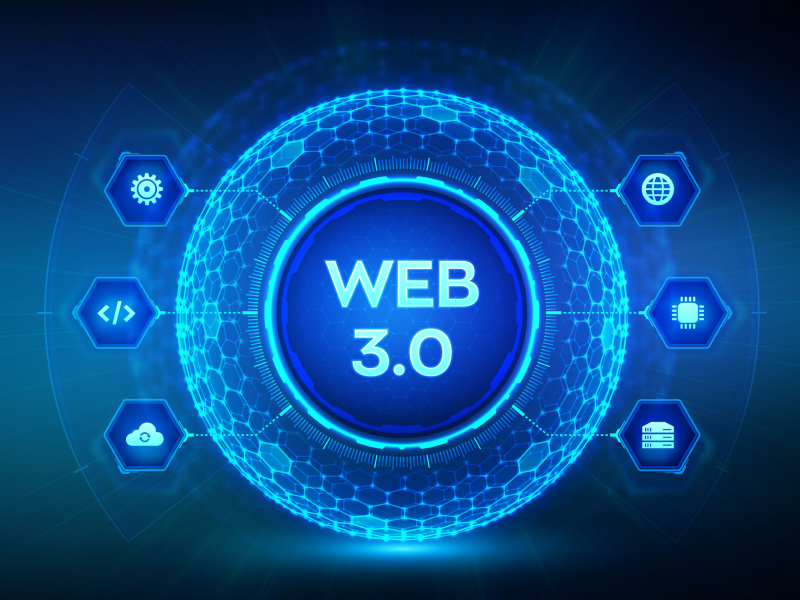In the ever-evolving tapestry of the internet, a profound transformation is taking place – the rise of Web 3.0. As we bid farewell to the constraints of Web 1.0’s static websites and the centralized structures of Web 2.0, Web 3.0 emerges as a beacon of innovation, ushering in an era where decentralization, user empowerment, and unparalleled interactivity reign supreme. In this comprehensive exploration, we embark on a profound journey into the heart of Web 3.0, unraveling its multifaceted impact on our lives, businesses, and the very essence of the global digital landscape. Join us as we delve deeper into this next-generation web, where blockchain technology, digital ownership, and a newfound sense of autonomy redefine our online existence.
The Dawn of Decentralization
At the heart of Web 3.0 lies the revolutionary concept of decentralization. Unlike its predecessors, Web 3.0 envisions a digital realm where power is distributed, not concentrated. Blockchain technology, the linchpin of this paradigm shift, allows data to be stored across a network of computers, eliminating the vulnerabilities associated with centralized servers. This decentralized architecture not only ensures unparalleled security and transparency but also grants individuals unprecedented control over their digital footprint. The internet, once dominated by tech giants, is now becoming a democratic space where users actively participate, shaping the online landscape.
In the realm of Web 3.0, the power dynamic shifts from corporations to individuals. Users, armed with cryptographic keys, control their digital identities and assets. Blockchain’s immutability ensures that once a transaction is recorded, it cannot be altered, fostering trust in online interactions. Smart contracts, self-executing agreements with the terms directly written into code, automate processes without the need for intermediaries, making transactions efficient and transparent. This decentralization not only empowers users but also fosters innovation, paving the way for applications previously deemed impossible.
Digital Identities and Sovereignty
One of the most transformative aspects of Web 3.0 is the concept of digital identity sovereignty. In traditional online ecosystems, user data was susceptible to breaches, leading to privacy concerns and identity theft. Web 3.0 addresses these issues by offering self-sovereign identities. In this model, individuals have full control over their personal information, deciding what to share, with whom, and for how long. This shift not only ensures enhanced privacy but also mitigates the risks associated with centralized data storage.
Moreover, portable and self-sovereign digital identities enable seamless interactions across various platforms. Imagine a world where you create a digital identity once, and it accompanies you across social media, banking services, healthcare platforms, and more, all while ensuring your data remains secure and under your control. Web 3.0 makes this vision a reality, fostering a digital ecosystem where individuals are not merely users but active participants in shaping their online personas.
Redefining Digital Ownership and Creativity
In the landscape of Web 3.0, digital ownership takes center stage, transforming the way we perceive and trade digital assets. Non-fungible tokens (NFTs), unique digital assets verified using blockchain technology, have revolutionized the creative industry. Artists, musicians, game developers, and content creators can tokenize their creations, proving their authenticity and ownership. This digital provenance ensures that creators receive due credit and compensation for their work, disrupting the traditional paradigms of intellectual property.
Furthermore, NFTs open up new avenues for fans and collectors to engage with their favorite artists. Collectible digital art, music albums, virtual real estate, and even tweets can now be tokenized and owned by enthusiasts, creating a vibrant ecosystem of digital collectibles. This not only provides novel revenue streams for creators but also fosters a sense of community and connection among fans, leading to innovative collaborations and artistic expressions.
Web 3.0 and Economic Transformation
The impact of Web 3.0 extends far beyond individual empowerment; it reshapes the very foundations of economies worldwide. Decentralized finance (DeFi), a significant component of Web 3.0, democratizes financial services.Decentralized blockchain networks now conduct traditional banking functions such as lending, borrowing, and trading.. This inclusionary financial system transcends geographical boundaries, providing opportunities for the unbanked and underprivileged to access banking services, fostering financial literacy and economic stability.
Additionally, Web 3.0 nurtures the growth of the gig economy. Smart contracts enable seamless, instant, and transparent transactions between employers and freelancers. Workers, irrespective of their location, can participate in global job markets, receiving payments in cryptocurrencies without the delays associated with traditional banking systems. This borderless AI jobs market fosters innovation and collaboration, leveraging the collective skills of individuals from diverse backgrounds and cultures.
Overcoming Challenges and Nurturing Innovation
While the promises of Web 3.0 are transformative, they are not without challenges. Scalability, regulatory frameworks, and interoperability issues are formidable obstacles on the path to widespread adoption. However, the tech community’s response to these challenges exemplifies the spirit of innovation. Developers and researchers are collaborating to create scalable blockchain solutions, ensuring the seamless integration of Web 3.0 technologies. Policymakers are engaged in crafting regulatory frameworks that strike a delicate balance between fostering innovation and ensuring user protection. This collective effort showcases the resilience of the global tech ecosystem, emphasizing the adaptability and creativity of the human intellect in the face of challenges.
Embracing the Future Together: A Call to Action
In the narrative of Web 3.0, we are not passive spectators; we are active participants, co-creators of the digital future. The dawn of this decentralized era demands collaboration, curiosity, and a pioneering spirit.
Developers craft innovative applications and solutions. Users embrace the principles of digital ownership and sovereignty. They both play pivotal roles in this transformative journey. The power to shape the internet as an inclusive, empowering space resides within our collective hands.
As we venture into this uncharted territory, we envision a future where the internet transcends its limitations. It becomes an inclusive space for creativity, innovation, and collaboration.
Also, read The Artificial Intelligence Buzz: A Journey through Technological Marvels
In a world increasingly dominated by technology, artificial intelligence (AI) has emerged as a beacon of innovation, revolutionizing how we interact with the digital realm. From the familiar voices of Alexa, Google Assistant, and Cortana guiding us through our daily tasks to the awe-inspiring concept of self-driving cars navigating our roads, AI has seamlessly woven itself into the fabric of our lives. This technological marvel has not just generated noise; it has orchestrated a symphony of transformation across various industries.
The Rise of Artificial Intelligence: A Phenomenon in IT
Its evolution has been nothing short of spectacular, permeating diverse sectors and reshaping the way we perceive technology. The applications of AI are as vast as the imagination, with image and speech recognition, ride-sharing apps like Uber, and even the intricacies of Google Maps being transformed by its prowess. The growth trajectory of AI is nothing short of astonishing, with market analysts predicting a staggering market cap of around 190 billion dollars in the near future.
Exploring the Boundless Horizons: AI in Various Applications
Imagine a world where machines can comprehend images and speech as effortlessly as humans. This seemingly futuristic concept is now a reality, thanks to the wonders of artificial intelligence. AI algorithms have been meticulously crafted to understand the nuances of images, making applications like facial recognition and image classification startlingly accurate. AI is transforming how we navigate. Google Maps, a travel staple, uses AI to optimize routes, predict traffic, and suggest places. Machine learning makes these systems accurate and intuitive, revolutionizing digital maps.
Revolutionizing Mobility: AI in Ride-Sharing Apps
In the era of ride-sharing, AI plays a pivotal role in enhancing the efficiency and user experience of platforms like Uber and Lyft. Behind the scenes, AI algorithms analyze vast amounts of data, including traffic patterns, user behavior, and driver availability. This analysis fuels real-time decision-making, ensuring that you get the nearest ride in the shortest possible time.
The Enigma of Potential: AI Salaries and Career Prospects
Unraveling Lucrative Avenues: High Incomes in AI
The allure of AI extends beyond its technological marvels; it encompasses the promise of lucrative careers and financial stability. In today’s professional landscape, AI-related roles offer some of the highest incomes available. From machine learning engineers earning over $125,000 per year to AI architects commanding an impressive $145,000 annually, these roles are not just jobs; they are gateways to financial success. The demand for skilled AI professionals continues to soar, creating a market where expertise is not just valued but handsomely rewarded.
AI and Career Aspirations: The Path to Success
For individuals aspiring to dive into the realm of AI, the future holds boundless opportunities. These careers not only promise financial rewards but also offer the chance to be at the forefront of technological innovation. As industries across the globe integrate AI into their operations, the need for skilled professionals is escalating, making it the perfect time to invest in AI education and skill development.

